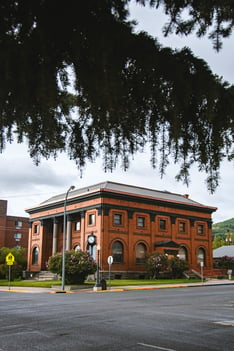Old commercial buildings across the United States, and around the world, are finding new life as they are being repurposed with interesting results.
Repurposing old commercial buildings can be a sustainable solution that helps revitalize neighborhoods, turning potential eyesores into prized public and private space.
“When retailers or businesses move out of existing buildings in a community, the empty space can create this apathy for the neighborhood causing it to tumble into further disrepair,” writes HMC Architects. “What started out as one business vacating can easily turn into an entire neighborhood disintegrating. However, when these buildings are brought back from the dead and repurposed, the possibilities for revitalization are endless.”
Advantages of Repurposing Old Commercial Buildings
HMC Architects says the advantages of repurposing a building are numerous ranging from sustainability, cost savings, availability of open land, historical significance, and the positive psychological impact on neighborhoods.
Of these benefits, the top two are:
- Sustainability: HMC Vice President of Sustainability Eric Carbonnier says, “The most sustainable thing you can do is to reuse an existing building. This is because the carbon footprint is already encapsulated within it.”
- Cost Savings: Abandoned commercial buildings can often be purchased at a significant reduction in price, including some that have gone for pennies on the dollar. HMC Architects estimates that owners can expect to see a cost savings of between 20 and 60 percent when repurposing an existing structure vs. building new.
Looking for “Good Bones” to Repurpose a Building
Some old commercial buildings make better candidates than others for repurposing. It all depends on if the building has “good bones”. Old warehouses, factories, banks, schools, and even old box stores can make great repurposed buildings.
HMC Architects says when looking for “good bones” focus on the existing buildings:
- Floors

- Walls
- Roof
- Building envelope or footprint
- Existing utility systems
- Mechanical systems
- Plumbing systems
Before jumping into a building repurposing, always conduct a thorough assessment of the existing building.
Five Interesting Repurposed Buildings
Almost every community and city in the U.S. now has repurposed buildings.
Here are five of our favorites:
Workhouse Arts Center (Fairfax, Virginia)
Former Correctional Facility Turned into Arts Center
The story of the Workhouse began more than 100 years ago when President Theodore Roosevelt appointed a penal commission to investigate the overcrowded and unsanitary conditions present at the District of Columbia Jail.
Congress approved the purchase of a 1,155- acre tract of land north of the Occoquan River in Virginia, and the first prisoners arrived in 1910. They built wooden structures from trees along the bank of the river which were replaced by brick structures in the 1920s.
The Workhouse gradually became an agricultural work camp which included cultivated fields, pastureland, orchard, cannery, poultry farm, hog ranch, slaughterhouse, dairy, blacksmith shop, and sawmill.
The area in use by the District of Columbia’s Correctional Complex increased to over 3,200 acres during its 91 years of operation but by the late 1980s the prison was known for overcrowding conditions and was ordered shut down with the last prisoner leaving in November of 2001.
In 2002, Fairfax County bought 2,324 acres for $4.2 million and turned it into the Workhouse Arts Center, which opened after extensive repurposing in September 2008.
The Workhouse consists of six artist studio buildings, the main galleries, dance studios, music rooms, outdoor performance and event space, and the W-3 Theatre.
South Carolina State Museum (Columbia, South Carolina)
Former Cotton Mill Turned into Museum
The South Carolina State Museum is located along the banks of the Congaree River in downtown Columbia on an old shipping canal.
The museum opened in 1988 in the former Columbia Mills Building, a former cotton mill listed on the National Register of Historic Places.
The Columbia Mills Building opened in 1894 and manufactured cotton duck cloth (canvas-like material). The building was known as the first totally electric textile mill in the world, home to the first major industrial installation by General Electric.
On certain levels of the museum, original flooring has been kept intact with its textile brads and rings embedded in the floor.
The museum has been around long enough that a 2014 expansion helped “repurpose the repurpose” as original cotton mill architectural features that had been covered up by carpet and drywall were left exposed for visitors to enjoy the original character of the building.
Plains Art Museum (Fargo, North Dakota)
Former Tractor Factory Turned into Art Museum
One of the top museums in the Midwest is housed in a former International Harvester tractor factory. The Plains Art Museum opened in October 1997 in a downtown Fargo warehouse that was built in 1904.
The warehouse, which featured large windows and skylights, was repurposed to feature 56,000 square feet of which 9,000 have security, climate, and light control properties.
The building is fully accessible and contains the Hannaher’s, Inc. Print Studio, The Dawson Studio, The Store, the Goldberg Art Lounge, meeting and reception space, frame shop, wood shop, visitor services center, performance areas and permanent collection storage and care areas.
A skybridge connects the original museum building with a 25,500 square foot expansion that houses The Katherine Kilbourne Burgum Center for Creativity.
Ivywild School (Colorado Springs, Colorado)
Elementary School Turned into Multi-Use Center Including Brewery, Bakery, Bar, Deli and Office Space
School may be out forever at the Ivywild School in Colorado Springs but the elementary school is still a focal point of the community thanks to creative repurposing.
Built in 1916, the school closed in 2009. Shortly after that, a group purchased the building and plans were made for Bristol Brewery to move into the space along with a bakery, espresso/cocktail bar, delicatessen, and office space.
Community leaders and neighbors were involved in every stage of the process to help gain their support. Today community gardens on the former school grounds help supply local restaurants with freshly grown ingredients.
Crowne Plaza Indianapolis Downtown Union Station
Former Train Station Turned into Hotel
This one is for train buffs – the Crowne Plaza Indianapolis Downtown is in the historic train shed of Union Station. In fact, guests can sleep in one of 18 original Pullman train cars still sitting on their original tracks.
The train station, built in 1888, was America’s first named Union Station and once had a young inventor named Thomas Edison working as a telegraph operator on the premises.
Presidents Theodore Roosevelt, Woodrow Wilson, Franklin D. Roosevelt, Harry Truman, and Dwight D. Eisenhower were some of the prominent figures to walk through Union Station.
The Station itself has gone through two repurposes, first when it was turned into a mall called the Festival Market Place that opened in 1986, and then the Crowne Plaza Hotel in 1996.







